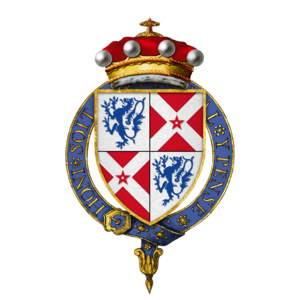William Neville, Earl of Kent facts for kids
Quick facts for kids
William Neville
|
|
|---|---|
| Earl of Kent | |
| Born | c. 1405 |
| Died | 9 January 1463 (aged 57–58) |
| Noble family | Neville |
| Spouse(s) | Joan de Fauconberg, suo jure 6th Baroness Fauconberg |
| Issue | Lady Alice Neville Lady Elizabeth Neville Lady Joan Neville Thomas Neville, the Bastard of Fauconberg (illegitimate) |
| Father | Ralph Neville, 1st Earl of Westmorland |
| Mother | Joan Beaufort |
William Neville, Earl of Kent (around 1405 – 9 January 1463) was an important English nobleman and soldier. He was also known as the 6th Baron Fauconberg through his wife.
William Neville fought in two major conflicts. He took part in the later years of the Hundred Years' War against France. He also fought in the Wars of the Roses, a series of battles between English noble families.
Contents
Early Life and Family
William Neville was born around the year 1405. He was the third son of Ralph Neville, 1st Earl of Westmorland. His mother was Joan Beaufort.
Joan Beaufort was the daughter of John of Gaunt, 1st Duke of Lancaster. John of Gaunt was a son of King Edward III of England. This meant William Neville was a great-grandson of King Edward III.
William Neville made a very good marriage. He married Joan de Fauconberg. She was the heir to the Fauconberg family lands and titles. Because of this marriage, William became known as Lord Fauconberg. His marriage happened before 1422. The Fauconberg family owned lands in North Yorkshire. This area was also a power center for other members of the Neville family.
A Soldier's Career
William Neville had a long military career. He was made a knight in May 1426. By 1435, he was serving on the Scottish border. In 1436, he went to France with Richard, Duke of York. This was his first time working with the Duke of York, who would later become a key ally.
By 1439, William was a field commander in France. He fought alongside other important lords. He helped capture and defend the town of Meaux. For his bravery in these campaigns, he was made a Knight of the Garter. This was a very high honor. In October 1440, he helped recapture the town of Harfleur.
In 1443, William Neville returned to England. He was given control of Roxburgh Castle in Scotland. He was paid a large sum of money for this role. However, in 1449, he went back to France on a diplomatic mission. During this time, he was captured by the French. He spent two years as a prisoner. He even used his own money to help pay for the castle where he was held.
When he was finally freed in 1453, he was very poor. He was owed a lot of money by the government. He had to accept less money than he was owed. Despite these difficulties, he remained loyal to the King for a while.
Changing Sides in the Wars of the Roses
For many years, William Neville was a loyal supporter of King Henry VI of England. Henry VI belonged to the House of Lancaster. However, William's loyalty began to change around 1453.
He joined the council of Richard, Duke of York. The Duke of York was a rival to King Henry VI. William's brother, the Earl of Salisbury, and his nephew, the Earl of Warwick, were already strong allies of the Duke of York. This family connection helped William decide to support York.
In 1457, William Neville became the deputy to his nephew, the Earl of Warwick. Warwick was the Captain of Calais, an important English stronghold in France. From Calais, Warwick launched naval attacks. William Neville helped him with these actions.
Later Life and Achievements
As the Duke of York's side gained power, William Neville received many rewards. He became a member of the King's Council. He was also made the Lieutenant of the North. On November 1, he was given the title Earl of Kent. He was also appointed Steward of the Royal Household. In 1462, he became Lord Admiral, in charge of the navy.
King Edward IV, who was now on the throne, relied on William Neville for both land and sea battles. After a big victory at the Battle of Towton, William helped the King take control of Northumberland. He led a group of 120 soldiers in Newcastle. He also helped in the siege of Alnwick Castle in 1462.
Between these land campaigns, he returned to Calais. From there, he led naval raids along the French coast. He attacked towns like Le Conquet and the Ile de Re.
William Neville died on January 9, 1463. He was buried at Gisborough Priory. He did not have any surviving sons from his marriage. This meant his title of Earl of Kent ended with him. He had three daughters and one acknowledged illegitimate son. His illegitimate son, Thomas Neville, later led a rebellion.
William Neville was a very successful military leader. He played a key role in the rise of the Yorkist side during the Wars of the Roses.
Images for kids



